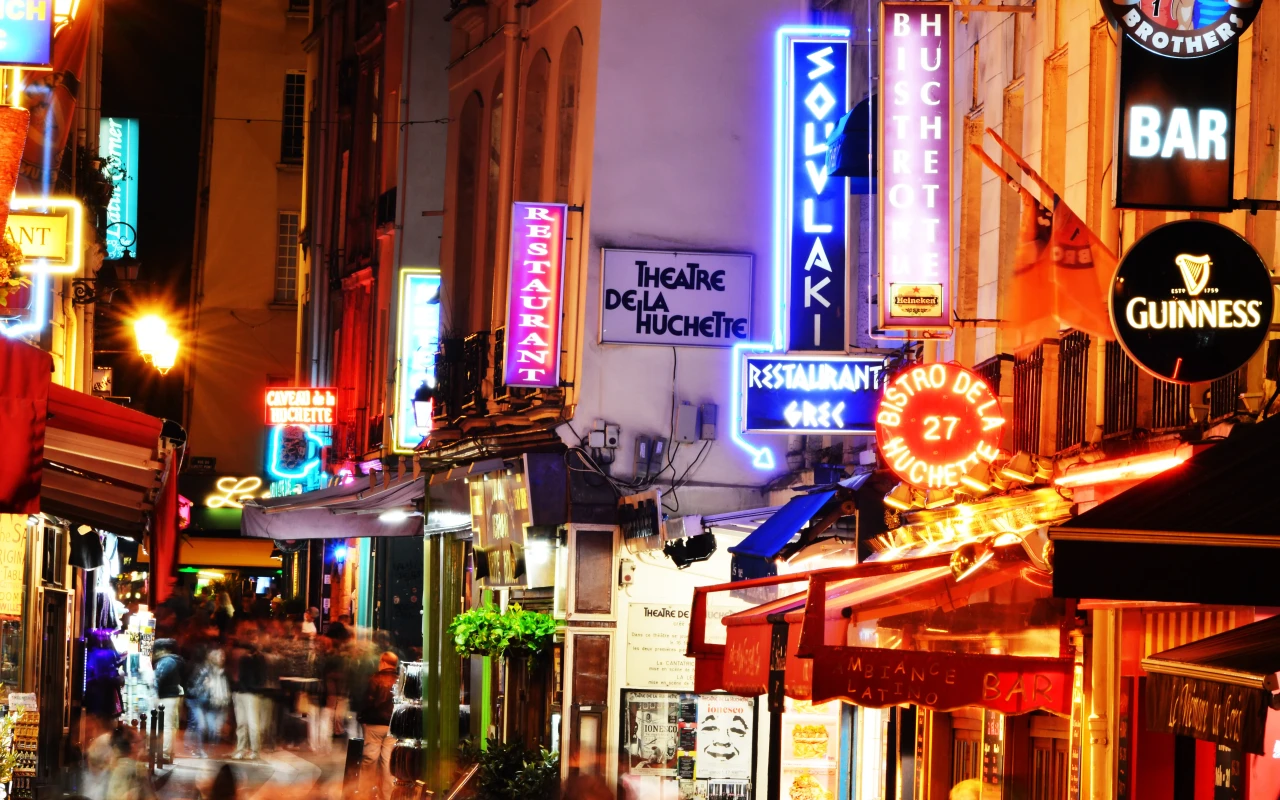Claim to Fame
The Latin Quarter is Paris’s historic academic heart — a vibrant neighborhood where ancient Roman ruins, medieval streets, and bustling cafés blend with the energy of students from the Sorbonne.
📌 Navigating Latin Quarter : Answers to Frequently Asked Questions
- Important Information: Check local event schedules as the Latin Quarter frequently hosts book fairs, markets, and cultural festivals.
- Washrooms: Public restrooms are available but can be scarce; facilities in bars and cafes may be used typically for customers.
- Hours of Operation: The district is vibrant both day and night, with shops and eateries having varied hours.
- How Long to Visit: Visitors can spend a few hours to a full day exploring the shops, cafes, and historic sites.
- Admission Fee: No admission fees to walk through the area, but museums and other attractions may charge.
- Parking: Street parking is limited; public transportation is recommended, with Saint-Michel and Cluny-La Sorbonne Metro stations nearby.
- Family Friendly: This historic district is filled with bookshops, cafes, and small museums, making it a delightful area for families to explore.
- Photography: The vibrant street life and historical architecture offer abundant photography opportunities.
- WIFI: WIFI is readily available in cafes and public spaces throughout the quarter.
- Picnic Area: While there are no designated picnic areas, the nearby Luxembourg Gardens offer a perfect spot for an outdoor meal.
- Handicap Accessible: Most areas are accessible, though some historic sites and narrower streets may be challenging for those with mobility issues.
- Pets: Pets are commonly seen in the area, but access may be restricted in certain restaurants and shops.
- Guided Tours: Guided tours are available to explore the historic and literary significance of the area, including visits to famous landmarks like the Panthéon and Sorbonne University.
- Restaurant or Cafe: The area is renowned for its variety of dining options, from quaint bistros to international cuisine.
- Gift Shop: Bookstores and boutique shops offer a range of unique gifts and souvenirs, reflecting the intellectual and artistic heritage of the district.
Photos of Latin Quarter
Located on the Left Bank of the Seine, the Latin Quarter is one of Paris’s oldest and most atmospheric neighborhoods. Its name dates back to the Middle Ages, when Latin was the language of scholars, and students flocked here to study at the newly founded University of Paris. Today, the quarter remains a cultural hub, full of winding streets, cozy bookshops, and intellectual charm.
What to Expect
Wander narrow cobblestone alleys that reveal hidden courtyards, historic churches, and lively squares. The neighborhood is dotted with independent bookstores, art cinemas, and family-run restaurants serving classic French fare. Don’t miss the iconic Shakespeare and Company bookstore, or the bustling food scene along Rue Mouffetard.
The Latin Quarter also boasts several architectural gems, including the Panthéon, where many of France’s greatest thinkers are buried, and the Cluny Museum, home to medieval artifacts like the famous Unicorn Tapestries.
Background and Cultural Context
The Latin Quarter has long been associated with learning, literature, and revolution. From the 12th-century founding of the Sorbonne to the student protests of 1968, it has been the backdrop for intellectual ferment. Writers like Hemingway, Camus, and Joyce all spent time here, and the legacy lives on in its cafés and literary haunts.
Despite its popularity, the quarter has preserved much of its authentic spirit, offering visitors a look at Paris beyond the monuments — one of cafés, conversation, and everyday life.
Best Time to Visit
Late mornings and early evenings are ideal, especially on weekdays. Weekends can be crowded, especially near tourist hotspots. Visiting in spring or fall offers the best weather and ambiance.
How to Get There
Take the Metro to Cluny–La Sorbonne (Line 10) or Saint-Michel (Line 4, RER B/C). From Notre-Dame Cathedral, it’s just a short walk across the Seine via the Petit Pont.
Photo Opportunities
- Classic Parisian cafés and terraces along Rue de la Huchette
- The monumental dome of the Panthéon
- Roman-era ruins at the Thermes de Cluny
- Book-laden window displays of Shakespeare and Company
Travel Tips
- Bring cash — some small eateries and bookstores don’t accept cards.
- Wear comfortable shoes — the cobblestones and hills can be uneven.
- Explore side streets and alleys to discover hidden courtyards and quiet spots.
- Grab a crêpe from a street vendor and enjoy it in Square René Viviani beside Notre-Dame.
FAQs
Why is it called the Latin Quarter?
Because Latin was the language of instruction at the medieval University of Paris, and students used it in daily life.
Is the Latin Quarter safe to walk at night?
Yes — it’s lively and well-trafficked, especially around major streets and squares. As always, exercise typical urban awareness.
Are there guided tours available?
Yes — both walking tours and themed literary or historical tours are popular ways to explore the area’s layered past.
Final Thoughts
The Latin Quarter is Paris at its most timeless — where education, rebellion, literature, and café culture converge. Whether you're browsing books, sipping wine, or soaking in centuries of history, this quarter invites you to slow down and savor the city’s intellectual soul.
